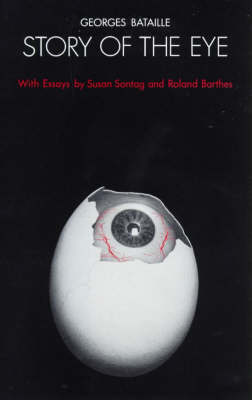Reviewed by Michael @ Knowledge Lost on
With a little help from French literary theorist Roland Barthes and his accompanying essay “The Metaphor of the Eye”, I quickly discovered that Story of the Eye is far more complex than I originally thought. However if you do read Georges Bataille’s introduction before the book like I did you will discover a few titbits that help decipher the surrealist nature of the novella. In this introduction Bataille talks about his love/hate relationship with his father, a man who went blind on account of neurosyphilis. He shares a memory he remembers clearly in his head of his father urinating and the vacant look in his milky eyes.
The reason this story is important to Story of the Eye is because the novella often references urination and eyes in the midst of the sexual acts. As Barthes explains in his essay, “Although Story of the Eye features a number of named characters with an account of their sex play, Bataille was by no means writing the story of Simone, Marcelle, or the narrator”. The act of sex is often accompanied with some form of violence. The eyes, milk, urine can all be seen as a reference to his memory of his father and any reference to testicles and eggs could be interpreted as metaphors to the creation of life.
While Roland Bathes goes into a far deeper analysis of the metaphors found in Story of the Eye, a slight understanding of the content changes this books topic from sexual perversions to an angry rant directed towards Bataille’s father. There are other reference found in the novella that connect to his life; for example the priest. Georges Bataille went into the seminary in the hopes of becoming a priest, however he had to drop out to find a job to support his mother, killing his dream. A topic I believe is discussed in more detail in his non-fiction book Eroticism.
I found myself being absorbed in Story of the Eye (which was translated by Joachim Neugroschel, Dovid Bergelson); although difficult to read, the symbolism really intrigued me. So much so that I had to order my own copy of the book in the hopes to re-read it soon. I read this as an ebook and I now own a physical copy which features the essays “The Pornographic Imagination” Susan Sontag and of course “The Metaphor of the Eye”. I am fascinated by the surreal erotic style of Bataille; I think he is an author I need to explore in greater details.
This review originally appeared on my blog; http://www.knowledgelost.org/literature/book-reviews/genre/erotica/story-of-the-eye-by-georges-bataille/
Reading updates
- Started reading
- 28 May, 2015: Finished reading
- 28 May, 2015: Reviewed
- Started reading
- Finished reading
- 28 May, 2015: Reviewed
